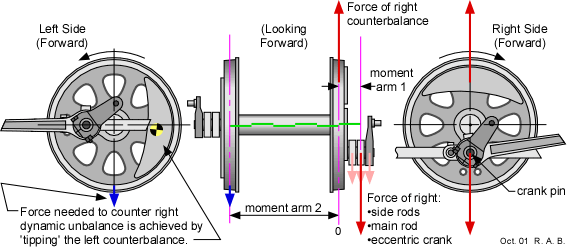Why Are the Main Driver Counterbalances Not Symmetrical?
First, recall that locomotive drivers are quartered; ie: the right/left connecting rod pins are oriented 90 degrees apart. As one crank is on dead center, the other is at the position of maximum torque, and the power strokes are evenly spaced throughout the driver rotation. It appears that most locomotive drivers are quartered with the right side leading by 90 degrees, as illustrated. (At least one example however, PRR K-4s #1361 [link NLA], has 'left hand lead'.)

What may not be obvious is that the counterbalances are doing more than simply statically balancing the crank pin, side rods, main rod, and eccentric crank on their respective sides. The main driver counterbalances are "tipped" to provide a force component on one side (eg: left) to cross-balance a rocking couple caused by the opposite (eg: right) side rods and eccentric crank about their own counterbalance weight. This cross balancing renders the axle/driver assembly in dynamic balance as well as static balance. This concept is applicable for all axles, but apparently was done only for the main axle where the additional mass and larger moment arm of the main rod and eccentric crank is much more significant.
Additionally, notice that the eccentric crank tips a different direction on each side of the locomotive (when the side rod is down the eccentric crank slants toward the front of the locomotive for normal inside admission valve gear). The main axle counterbalance position takes this into consideration also, contributing further to irregularity of the counterbalance weights.
A site visitor (thanks, Tim) comments that few if any American locomotives were cross-balanced before around 1930 (?). Our example Soo #2714 Pacific may have gotten the cross-balanced counterweight design with the Boxpok main driver conversion (ca. 1951).
However, another visitor (thanks, John) cites Union Pacific/AlCo 4-12-2s, designed during 1925, as having noticable evidence of cross-balancing on both main driving axles ("tipping" of the counterbalance lunes).In the context of balance, it should be mentioned also that for this type of two cylinder (single cylinder per side) locomotive, the counterbalance weights balance all of the rotating mass per the above, but balance only a portion of the reciprocating mass.
The rotating mass (crank pins, each end of the side rods, back portion of main rod) can be theoretically perfectly balanced with counterbalance weight. However, the reciprocating mass (piston assemby, piston rod, crosshead, union link, bottom portion of combination lever, front part of main rod) cannot be balanced with the driver counterbalances. Any attempt to balance reciprocating mass only results in trading off horizontal unbalance for a vertical unbalance component (overbalance). This overbalance force, referred to as hammer blow, increases with the square of the velocity and is an undesirable characteristic of steam locomotives that was damaging to railbeds and bridges at higher speeds.
|
Home (& Links) |
4-6-2: #2714 Images |
Forward Animation |
Reversing Animation |
Walschaert Components |
|---|---|---|---|---|
|
Steam Engine PV Diagram |
Counterbalance Asymmetry |
Locomotive Insides |
Boiler Backhead |